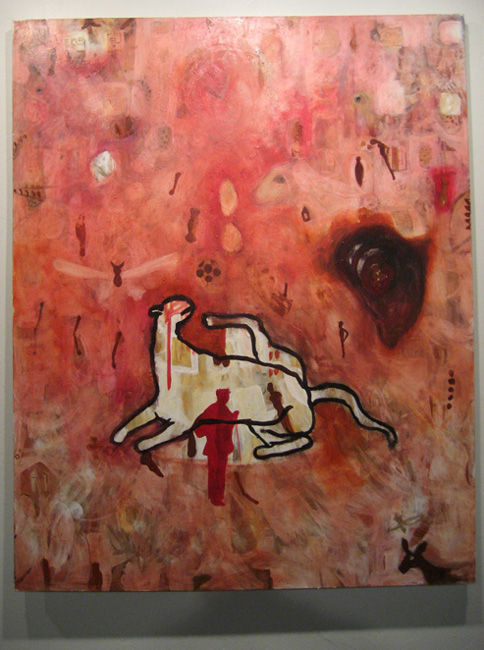Source: WTL digital photo of canvas in "Imagining of Place" art exhibition at Santa Fe College, 2009.
Permission: Nereida García Ferraz's email to WTL March 2, 2009.
Painting: "Africa;" oil on canvas; 40" x 60." At the bottom of the painting we see the shadow cast by the canvas on the gallery's south wall. In the exhibition this painting was placed between between "Obatala" to its left and "Mesquita" to its right (see next page).
Comments: My eyes fall first, of course, on the white outlined animal figure in the center at the top of the bottom third of the canvas; next I notice the curious verticality of this canvas and its dominant red and pink colors; next I notice the dark shape half way up and near the right edge of the canvas; this shape at first glance reminds me of the shape of Africa on a map or, perhaps, a dark ear; then my eye returns to the animal shape and I study some of its features: the red shape of a human (?) who is contained inside (!) the black outline of the animal's belly, the dark brown sword shape to the right, what look like drops of blood falling from the animal's head, and the awkward position of the animal's right rear leg. And I recall that, in general, Baroque era Hispanic paintings often are arranged in 1/3 to 2/3 distribution of space, with the bottom third containing the central figures and the top two-thirds open space (heaven, nature, tall walls, etc.). Also, I am reminded that one of the threads through all Latin American humanities both post-encounter and, possibly (though anachronistically), pre-encounter, can be thought of as "baroque."
Humanities Questions: (A) Does the organizational fact of this painting correlate with the general notion that García Ferraz's works have a Hispanic or Latino feel to them? Or, just this work? Or is this idea way off the mark? (B) What animal shapes can you make out in this painting? (C) Since the title is "Africa," why the dominant color to suggest this content or idea? (D) Note that, as the "curator" of this online version of the "Imagining of Place" show, I have placed this work last in a series of paintings that include human figures. Do you see an aesthetic progression in terms of this particular theme?

